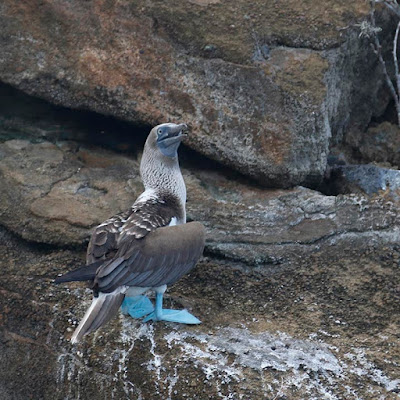The Galapagos Islands lie in the Pacific Ocean on
the equator and about 1,000 from the mainland of Ecuador. There are 13 major islands, 6 small islands
and scores of islets of which only some are named. Five of the islands are inhabited and about
half the residents live in Puerto Ayora (Santa Cruz). Most of the islands have two or more names,
the earliest charts gave names in both and Spanish and English and then in 1892
the Ecuadorian Government assigned official names. Makes in rather confusing at times!
The route your boat takes is designated by the
Galapagos Authorities, as are your particular landing times at each
destination. We didn’t know whether the
Western or Central Tour would be the best, but we did know we wanted a small
boat so we were happy with wherever the Beluga was going – Western Route;
Baltra (Airport), Santa Cruz, Floreana, Isabela, Fernandina, Santiago,
Bartolome, North Seymour and finally back to Baltra.

Overnight we sailed from Santa Cruz to Floreana (about 4 hours). One of the oldest islands and its volcano has long been extinct and is in the advance stages of erosion. This gives the island the nutrients and soils to sustain plant life. It’s known for its pink flamingos and good snorkelling.
Obviously it’s very humid in this area and the
boat is airconditioned – our room is particularly fridge like. Our first jaunt off the boat I took out my
camera and immediately it fogged up and took probably 1/2 hour to clear (I
should have known better, the opposite happened in Iceland). Within the first few minutes in the panga we
saw Galapagos Penguin (rare in this area) Blue Footed Boobies and sea lions –
all of which are a bit foggy!
The landing was a wet one but the water wasn’t
too deep so my camera bag wasn’t in any danger.
We walked a short distance to see the flamingos which quite frankly were
rather disappointing. Having been told
the animals (and I include birds, reptiles et al in this description) were so
close and so unbothered by humans, it was a complete let down to see only 5 or
so flamingos in the far distance.
This is half our group in one of the pangas, they
feel very safe and are quite fun to ride in but getting in and out can be
tricky sometimes.
From the panga we could see some land iguanas
waddling along the beach, this photos isn’t in focus sadly but it give an idea
how large they are.
And yet more sea lions, they really are very inquisitive
creatures.
Sally Lightfoot Crabs are everywhere but like
most of the wildlife, very hard to photograph when you’re bouncing around in
the waves.
We were lucky to see some more Galapagos
Penguins, these little ones reminded me of the wicked penguins in the film Madagascar, standing around plotting some deadly deed.
When the meeting was over they waddled into the
sea, one by one.
Back on the boat we had a quick change into
swimming clothes, squeezed ourselves into wetsuits and went snorkelling. Rebecca (Ian’s eldest) had recommended a full
face snorkelling mask and as Ian has always had troubled getting masks to fit
we thought we’d give them a go and they are absolutely brilliant. You do look very strange (who cares!) and you
can’t go under water as they are designed to cut off the breathing hole as soon
as water gets in, but for floating around on the service with your face in the
water – perfect.
In the afternoon we landed at Post Office Bay where the tradition is that you take away a card that you can either deliver personally or put a stamp on within your own country (jolly good idea I think, otherwise costs US$3.50 postage per card - the most we've paid anywhere). So we duly sorted through the barrel
and took away one the cards to post for a couple in Northampton.
Ian putting ours in the barrel – I wonder if we’ll ever see it again.
Ian putting ours in the barrel – I wonder if we’ll ever see it again.
We could then swim or snorkel again off the beach
but it was quite rough and there were some nasty sharp rocks around so as the
water wasn’t very clear we just splashed around a bit to cool off.
Back onboard for a quick sundowner





















